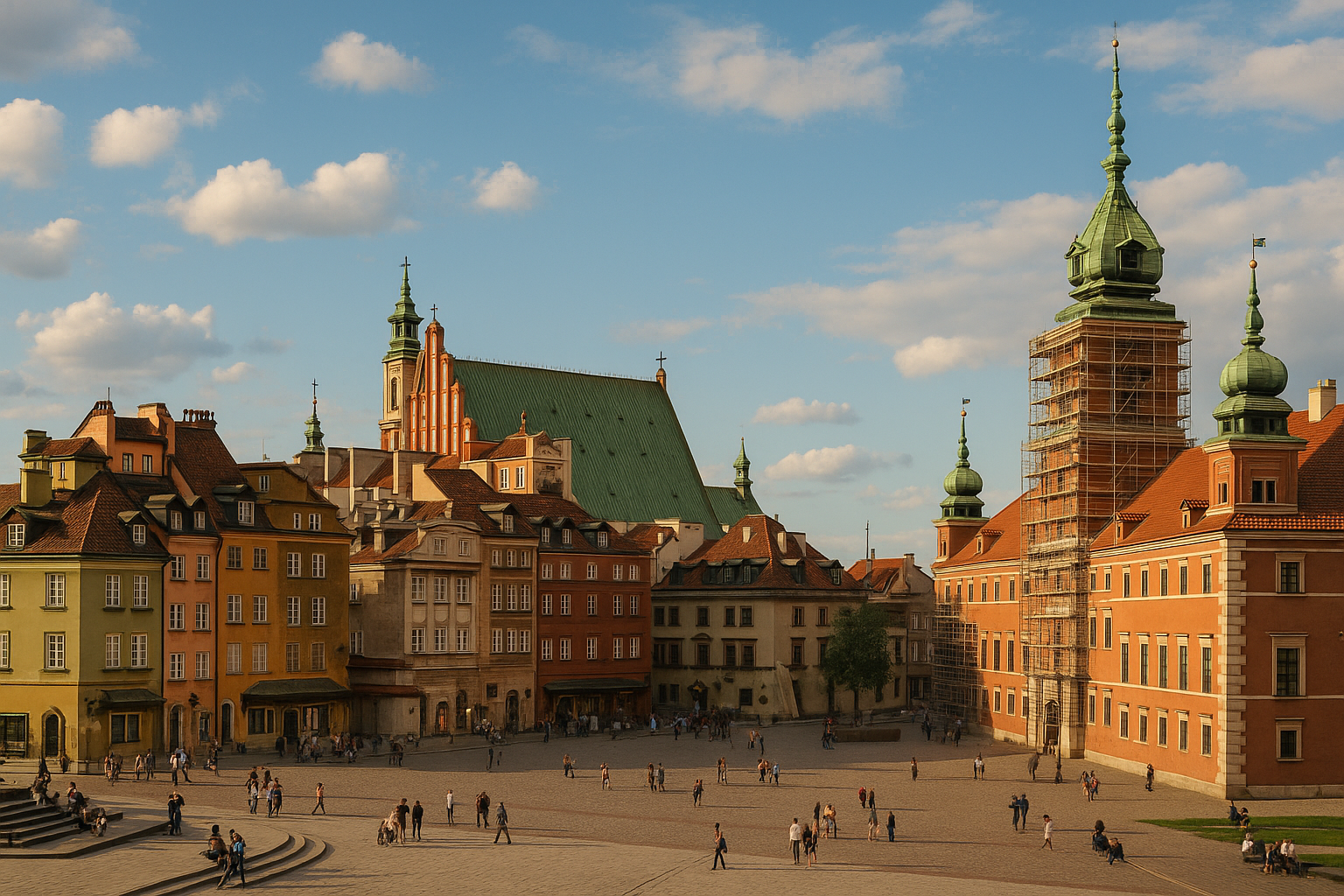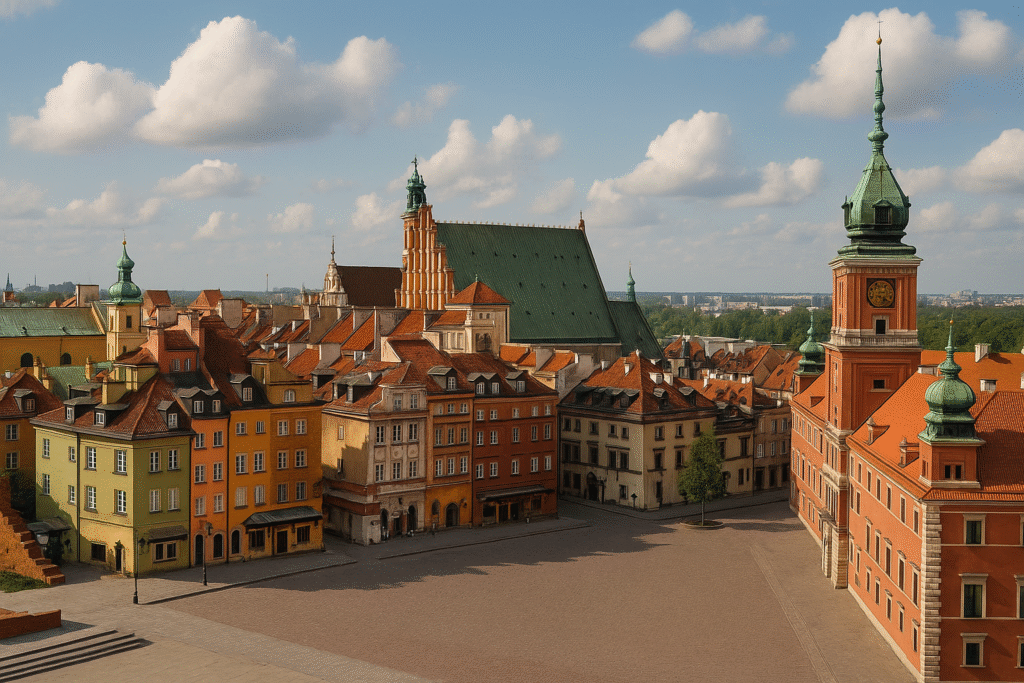Warsaw, the vibrant heart of Poland, is a city where the past and present intertwine seamlessly. As you stroll through its streets, you are greeted by a captivating blend of architectural styles—Gothic, Renaissance, Baroque, and Neoclassical—all standing in harmonious contrast to modern skyscrapers and contemporary designs. At the heart of this cultural mosaic lies Warsaw’s Old Town, a testament to both the resilience of its people and the enduring spirit of its history. This enchanting quarter, meticulously restored after the ravages of World War II, is a beacon of Poland’s cultural heritage and a UNESCO World Heritage site.
The Heartbeat of History
Warsaw’s Old Town, locally known as Stare Miasto, is the pulsating core of the city’s historical identity. Established in the 13th century, it was once the center of political, cultural, and economic life in Warsaw. Its cobblestone streets and colorful facades narrate tales of bygone eras, where merchants traded goods and artisans showcased their crafts. The Old Town Square, Rynek Starego Miasta, remains the heart of this district, offering a vibrant tableau of history and everyday life.
The destruction wrought by World War II left Warsaw’s Old Town in ruins, a shadow of its former glory. However, the determination to preserve the city’s heritage led to one of the most ambitious reconstruction projects in history. This endeavor was not merely about rebuilding structures but about reviving a cultural ethos that had been nearly obliterated. The painstaking process began immediately after the war, driven by a collective national spirit to reclaim and resurrect what had been lost.
A Masterpiece of Reconstruction
The rebuilding of Warsaw’s Old Town is often hailed as a masterpiece of reconstruction, blending historical accuracy with innovative restoration techniques. Architects, historians, and artisans collaborated to ensure that every detail, from the intricate stucco work to the vibrant murals, was faithfully recreated. They relied on an extensive collection of photographs, paintings, and architectural drawings to guide the restoration efforts.
The reconstruction was not without its challenges. The team faced the daunting task of balancing historical fidelity with modern needs. Yet, their dedication bore fruit as they managed to resurrect the Old Town’s charm and authenticity. The meticulous restoration of the Royal Castle and the iconic Sigismund’s Column are testaments to the success of this monumental task, both standing today as symbols of Warsaw’s resilience and pride.
Architectural Geniuses at Work
The architects behind the rebuilding of Warsaw’s Old Town were visionaries who understood the importance of preserving cultural heritage. They navigated the fine line between restoration and innovation, ensuring that the Old Town remained a living part of Warsaw, not just a frozen relic of the past. The reconstruction process became a laboratory for architectural experimentation, blending traditional techniques with contemporary insights.
This meticulous process extended beyond mere reconstruction; it was an act of cultural revival. The architects and artisans worked tirelessly to revive forgotten crafts, such as the art of sgraffito, a decorative technique that had fallen into obscurity. By reintroducing these techniques, they enriched the cultural tapestry of the city, ensuring that Warsaw’s Old Town would continue to inspire future generations.
The Cultural Rebirth
Beyond its architectural splendor, Warsaw’s Old Town embodies a cultural rebirth. Its streets are alive with music, art, and the vibrant energy of a city that has reclaimed its identity. The Old Town hosts numerous cultural events, from classical concerts held in the shadow of the Barbican to art exhibitions that celebrate both Polish and international artists. These events transform the Old Town into a dynamic cultural hub, attracting locals and tourists alike.
The Old Town’s culinary scene also plays a pivotal role in its cultural renaissance. Traditional Polish cuisine can be savored in quaint restaurants that line the streets, offering a taste of the local flavors that have been passed down through generations. The combination of history, culture, and cuisine creates an immersive experience, inviting visitors to not only witness but also participate in the living history of Warsaw’s Old Town.

A UNESCO World Heritage Site
In 1980, the efforts to rebuild Warsaw’s Old Town were recognized by UNESCO, which declared it a World Heritage site. This prestigious designation underscores the significance of the reconstruction project as a model for urban regeneration and cultural preservation. Warsaw’s Old Town is celebrated not only for its architectural beauty but also for the story it tells—a narrative of resilience, determination, and hope.
The UNESCO recognition has helped to ensure the continued preservation and promotion of Warsaw’s Old Town. It has become a symbol of national pride, highlighting the importance of safeguarding cultural heritage for future generations. As a World Heritage site, it attracts international attention, drawing visitors from around the globe who come to admire its beauty and learn about its remarkable history.
The Role of Modern Technology
The reconstruction of Warsaw’s Old Town was not solely reliant on traditional methods; modern technology played a pivotal role in its restoration. The use of advanced materials and techniques allowed for the strengthening of structural integrity while maintaining historical accuracy. 3D modeling and digital archives provided invaluable resources for architects, enabling them to recreate intricate details with precision.
Today, technology continues to play a role in the preservation of Warsaw’s Old Town. Digital tools are used to monitor the condition of buildings and plan maintenance efforts. Virtual reality experiences have also been developed, offering immersive tours that allow people worldwide to explore the Old Town’s history and architecture from afar, further expanding its reach and influence.
A Living Museum
Warsaw’s Old Town is often described as a “living museum,” a place where history is not only displayed but actively lived. Its streets and squares serve as stages for historical reenactments, cultural festivals, and public performances that breathe life into its storied past. The Old Town is a dynamic space where the past and present coexist, offering an ever-evolving narrative that captivates all who visit.
The educational potential of Warsaw’s Old Town is immense. Schools and universities frequently conduct tours and workshops within its bounds, using it as a real-world classroom to teach history, architecture, and cultural studies. This interactive approach to learning helps to instill a deep appreciation for cultural heritage among young generations, ensuring that the legacy of Warsaw’s Old Town will endure.
Engaging the Global Community
Warsaw’s Old Town has become a beacon for global dialogue on heritage preservation and urban regeneration. It serves as a case study for cities worldwide grappling with the challenges of balancing development and preservation. Conferences and symposiums are often held in Warsaw, bringing together experts and enthusiasts to share knowledge and strategies for safeguarding cultural heritage.
The global interest in Warsaw’s Old Town also extends to tourism, with visitors eager to experience its unique charm and history. The influx of international tourists has stimulated the local economy, fostering a vibrant hospitality industry while promoting cultural exchange. As more people discover the story of Warsaw’s Old Town, they become ambassadors for its legacy, spreading the message of resilience and revival far and wide.
Conclusion
Warsaw’s Old Town stands today as a testament to the indomitable spirit of a city that refused to let its history be erased. Through meticulous reconstruction and cultural revival, it has transcended its tragic past to become a symbol of hope and resilience. This remarkable district invites all who visit to walk its cobblestone streets, experience its rich cultural tapestry, and witness the triumph of human determination. As Warsaw’s Old Town continues to inspire and engage the world, it remains a living monument to the enduring power of heritage and the promise of renewal.

Recent Posts
15 Floor Plan Graphic Styles That Will Elevate Your Presentation Game
The Role of Shadows in Architectural Storytelling
When Furniture Becomes Architecture: Blurring the Line